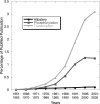Whence cometh the allosterome?
- PMID: 16818878
- PMCID: PMC1502268
- DOI: 10.1073/pnas.0604452103
Whence cometh the allosterome?
Abstract
Regulation of cellular functions can be accomplished by many mechanisms, including transcriptional regulation, alternative splicing, translational regulation, phosphorylation and other posttranslational covalent modifications, degradation, localization, protein-protein interactions, and small-molecule allosteric effectors. Largely because of advances in the techniques of molecular biology in the past few decades, our knowledge of regulation by most of these mechanisms has expanded enormously. Regulation by small-molecule, allosteric interactions is an exception. Many of the best-known allosteric regulators were discovered decades ago, when we knew little about all of these other forms of regulation. Allostery is the most direct, rapid, and efficient regulatory mechanism to sense changes in the concentration of small molecules and alter cellular responses to maintain homeostasis. In this perspective, we present the argument that allosteric regulation is underappreciated in the systems biology world and that many allosteric effectors remain to be discovered.
Conflict of interest statement
Conflict of interest statement: No conflicts declared.
Figures

References
-
- Bohr C. Zentr. Physiol. 1903;17:682.
-
- Cori G., Colowick S., Cori C. J. Biol. Chem. 1938;123:381–389.
-
- Crick F. Symp. Soc. Exp. Biol. 1958;XII:138. - PubMed
-
- Novick A., Szilard L. In: Dynamics of Growth Processes. Boell E. J., editor. Princeton: Princeton Univ. Press; 1954. pp. 21–32.
-
- Pardee A. B., Yates R. A. J. Biol. Chem. 1956;221:757–770. - PubMed
MeSH terms
Substances
LinkOut - more resources
Full Text Sources
Miscellaneous

